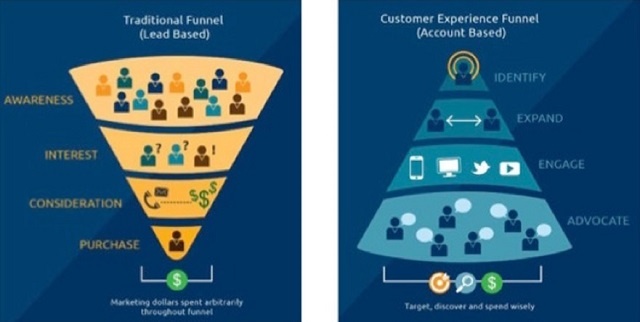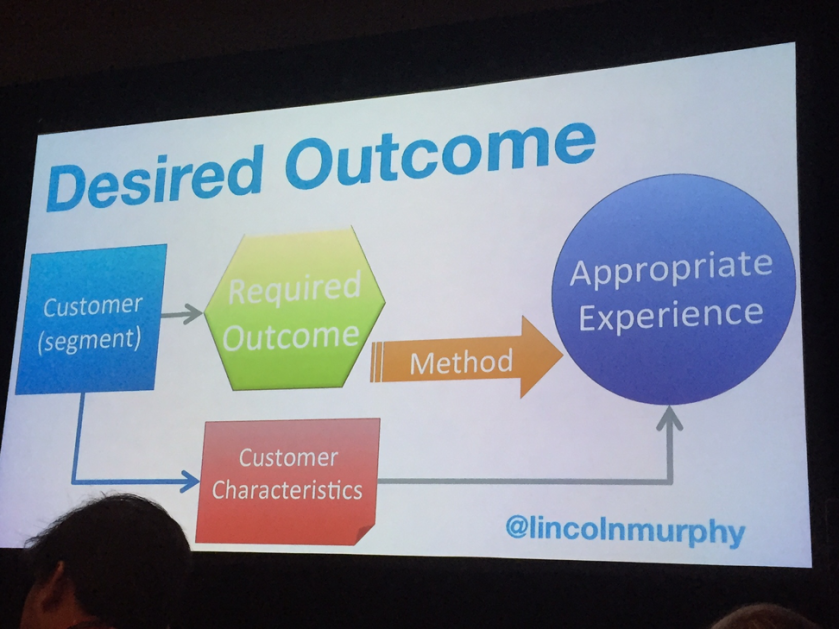Earlier this year, I attended the #FlipMyFunnel B2B Marketing and Sales Festival event in Austin, TX. The event is hosted by Terminus, who you may know is an account-based marketing company. So you’d think the conference would have been solely about ABM. And you’d be wrong. The topic that came up time and time again was a relentless focus on the customer, much to my delight.
(Full disclosure: I received a free pass from one of the speakers.)

One of my favorite statements came from Lincoln Murphy, who had this to say.
“We exist to alter the state of our customers. If we can make our customers powerful, they will make us powerful.”
He explained to attendees why the current situation in B2B marketing is not a power struggle and we don’t need to “take back the power from our customers.” We’re in this together and I love that idea of reciprocity in our relationship to customers.
In order to do this, we need to relentlessly focus on what customers want, what they need, and how we can create content that helps. This was the idea that surrounded the discussion of content from nearly every speaker I listened to at #FlipMyFunnel in Austin. And I furiously took notes.
The whole concept of “flipping the funnel,” according to Sangram Vajre, CMO at Terminus, relies on four key concepts.
- Identifying our best-fit customers and what they need and want
- Expanding our focus on the right people (which may not be simply one person within an organization, but many)
- Engaging with them using the right content on the right channels
- And turning customers—and even non-customers—into advocates

Identify
Personally, I’ve been so over the term “growth hacking” for a while. It has become such a ubiquitous term that people often use improperly. However, I became a believer when I attended the session with Sujan Patel, Co-founder of ContentMarketer.io, on growth hacking tips for identifying the needs of your customers. Though he gave many, here is one hack that fits perfectly in this step of the flipped funnel.
Contribute and add to secondary SEO sources – So maybe you don’t own the search results for terms important to your brand. But what you can do instead is participate and add value in places that do. This could be the comments section of popular blogs in your field, for example. Interact with people there, and look for what kind of questions they’re asking (you can do this on Quora, too). Use that to identify the challenges your customer base needs help solving, and position you or your brand as a subject matter expert.
Expand
In order to expand our audiences properly, we need to change and adapt our approaches. One of my favorite points from Joe Chernov, VP of Marketing at InsightSquared, was this.
“We need to get sales the audition, not the part. We’re not just looking for traffic—we need to provide our sales teams with substantive conversations.”
If we’re not identifying the right people with our marketing, we’re not setting our sales teams up for success, and not expanding our audience in a way that works for the audience OR sales. And that experience is becoming even more crucial to our success.
We also cannot expand our audiences if we’re not listening to them. Especially in B2B—a purchase isn’t simply a transaction; it’s a relationship. It means something, and customers are taking the time to do the research necessary for that to be a successful relationship. As Russ Somer, VP of Marketing at TrendKite, said during the CMO Chat:
“No matter what size your company, when you make a purchase, your job is on the line. So you’re going to do your research and see what others are saying.”
As marketers, we need to not only understand what our customers will be searching for, but have empathy for that process by making it as painless and seamless as possible.
Engage
Your content doesn’t exist in a vacuum. The atmosphere in which people engage with your content can make all the difference in the world. I love the analogy from Uberflip’s Head of Strategy, Hana Abaza:
“You could drink a piña colada in a dingy basement or a sunny beach. The piña colada is the same, but you’re going to enjoy it much more on the beach.”
The same goes for your content. The experience of consuming your content can make the content. We need to not only be creating content that people want and need—we have to present it to them in ways that make it enjoyable.
One great suggestion Hana gave was organizing your content by topic, not type. No one goes to your website searching for a bunch of whitepapers (audience chuckles uncomfortably, realizing many of us have our websites set up like this), but they may be going to your website looking for different types of content around a specific topic. Cater to that, give them the experience they want, and they’ll be back for more.
Advocates
There were numerous brilliant statements that came from Lincoln Murphy. He seems to have a passion for customer advocacy and how to attain it. One thing he spoke a lot about was “Desired Outcome.” This term means helping customers get what they need (the Required Outcome) in an appropriate means of achieving it (the Appropriate Experience). And as Lincoln puts it,
“Customer success is when customers achieve their Desired Outcome through their interactions with your company.”

The Desired Outcome is a conversation your customers are having that you need to be part of. Because when you help them solve problems in a way that works for them, that’s how you build brand advocates that will gladly spread the word about your company, products, and services. People remember those that help them.
The conference wrapped with a fantastic fireside chat with women in tech:
- Katharine Mobley, CEO and CMO at WeCareCard
- Katie Rogers, VP of Customer Success at SalesLoft
- Tonni Bennett, Director of Sales at Terminus
- Emily Wingrove, Director of Marketing at Synthio
It was a great way to close out the show with some insight on the current state of women’s roles in the tech industry, and wisdom for anyone coming up in the tech scene. I loved hearing from four women in different stages of their careers, talking about how we can improve things.
And speaking of creating better customer experiences, if you haven’t seen my session from the MarketingProfs Marketing Strategy virtual conference, you can check it out on this page. I discuss ways to maintain a human approach in your marketing. And it’s robot-themed.
Do you agree with the above approaches? What would you add? And if you’re taking this kind of account-based approach already, how is it working out for you? Make sure to comment below!
Now, go get your social on!
